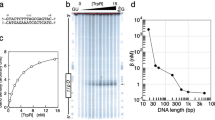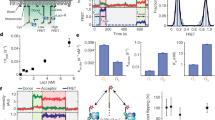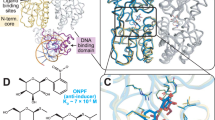Abstract
WE report here measurements of the rates of association and dissociation of the lac repressor and covalently closed λplac DNAs of various degrees of superhelicity, from which we deduce that the binding of repressor unwinds the lac operator by 40° to 90°. This small unwinding angle is inconsistent with binding mechanisms involving considerable disruption of DNA base-pairs and, in particular, with the model first proposed by Gierer1 for specific repressor–operator interactions. Our measurements were prompted by the existence of a twofold symmetry in the base sequence of the lac operator, which is a prerequisite of the Gierer model. The minimal base sequence of the lac operator, determined by Gilbert and Maxam2, is depicted in Fig. 1 as a regular double helix (Fig. 1a), and as a Gierer-type structure (Fig. 1b). According to Gierer's model, the lac repressor interacts specifically with the hairpinned structure shown in Fig. 1b.
This is a preview of subscription content, access via your institution
Access options
Subscribe to this journal
Receive 51 print issues and online access
$199.00 per year
only $3.90 per issue
Buy this article
- Purchase on Springer Link
- Instant access to full article PDF
Prices may be subject to local taxes which are calculated during checkout
Similar content being viewed by others
References
Gierer, A., Nature, 212, 1480–1481 (1966).
Gilbert, W., and Maxam, A., Proc. natn. Acad. Sci. U.S.A., 70, 3581–3584 (1973).
Bauer, W., and Vinograd, J., J. molec. Biol., 33, 141–171 (1968); 47, 419–435 (1970).
Davidson, N., J. molec. Biol., 66, 307–309 (1972).
Maniatis, T., and Ptashne, M., Proc. natnl. Acad. Sci. U.S.A., 70, 1531–1535 (1973).
Riggs, A. D., Suzuki, H., and Bourgeois, S., J. molec. Biol., 48, 67–83 (1970).
Riggs, A. D., Bourgeois, S., and Cohn, M., J. molec. Biol., 53, 401–417 (1970).
Jobe, A., and Bourgeois, S., J. molec. Biol., 72, 139–152 (1972).
Miller, J. H., Beckwith, J., and Müller-Hill, B., Nature, 220, 1287–1290 (1968).
Wang, J. C., in Procedures in nucleic acid research (edit. by Cantoni, G. L., and Davies, D. R.), 2, 407–416 (Harper and Row, New York, 1971).
Riggs, A. D., Newby, R. F., and Bourgeois, S., J. molec. Biol., 51, 303–314 (1970).
Wang, J. C., J. molec. Biol. (in the press).
Maestre, M., and Wang, J. C., Biopolymers, 10, 1021–1030 (1971).
Saucier, J. M., and Wang, J. C., Nature new Biol., 239, 167–170 (1972).
Wang, J. C., J. molec. Biol., 43, 263–272 (1969).
Author information
Authors and Affiliations
Rights and permissions
About this article
Cite this article
WANG, J., BARKLEY, M. & BOURGEOIS, S. Measurements of unwinding of lac operator by repressor. Nature 251, 247–249 (1974). https://doi.org/10.1038/251247a0
Received:
Revised:
Issue Date:
DOI: https://doi.org/10.1038/251247a0
This article is cited by
-
DNA supercoiling, a critical signal regulating the basal expression of the lac operon in Escherichia coli
Scientific Reports (2016)
-
Protein-induced DNA linking number change by sequence-specific DNA binding proteins and its biological effects
Biophysical Reviews (2016)
-
Protein-induced DNA linking number change by sequence-specific DNA binding proteins and its biological effects
Biophysical Reviews (2016)
-
Minor groove DNA-recognition by α-helices
Nature Structural Biology (1995)
Comments
By submitting a comment you agree to abide by our Terms and Community Guidelines. If you find something abusive or that does not comply with our terms or guidelines please flag it as inappropriate.



